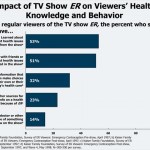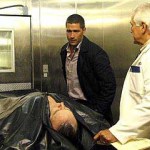Entertainment Media
Chiwetel Ejiofor as geologist Adrian Helmsley in last year's blockbuster 2012 is one of the many emerging "hero" images of scientists in popular film and television.
In graduate school, I published with several colleagues a paper examining the portrayal of scientists in film and television and the relationship to audience perceptions. At last week's workshop on science and art in Alberta, I had the opportunity to return to this topic, one that remains much debated by commentators and scientists.
Contrary to conventional wisdom that entertainment media portray science and scientists in a…
Over the summer, a few stories have appeared speculating about a new "twitter effect" on movie box office success. The technology is thought to speed-up and amplify the traditional word-of-mouth influence. For example, the less than anticipated opening weekend for Bruno is believed to be partially attributable to movie-goers leaving the film (sometimes early) and twittering a negative review.
Now it appears movie studios are attempting to turn the twitter effect in their favor. From today's Washington Post:
Studios are trying to gauge the impact of an avalanche of tweets and how it affects…
Tomorrow night, watch Spencer Tracy argue in defense of evolution.
For readers in the DC area, tomorrow night at 7pm, the NIH Office of Science Education and the American Film Institute are teaming up to sponsor a screening of Inherit the Wind as part of their summer film series "Science in the Cinema."
Following the film, I have been invited to make a few remarks on the evolution debate as it plays out in contemporary culture and the enduring themes from the classic movie. The event and film series is designed to facilitate active audience participation and debate, so I expect there will be…
A 1997 poster appearing in Central Park.
Perhaps the best commentary on the cultural reaction to Michael Jackson's death comes from the NY Times' columnist Bob Herbert. After describing meeting Jackson in the mid-1980s as one of the "creepier experiences" of his life, Herbert goes on to discuss how Jackson was the perfect symbol of the age, a retreat for Americans into fantasy during the years of the Reagan administration, rising poverty, and an escalating crack and drug epidemic. As Herbert writes:
In many ways we descended as a society into a fantasyland, trying to leave the limits and…
As we discuss in a current working paper, the "going broad" strategy of using entertainment media to reach wider audiences was first pioneered in the area of health.
For example, working in collaboration with experts, screenwriters for the series ER purposely inserted plot scenarios intended to raise attention to beneficial health behaviors. Evaluation of the efforts found important impacts in raising awareness, discussion, and interest in the featured health topic among viewers. More recently, a special issue of the American Journal of Bioethics evaluated the use of programs such as House…
It started this morning with the front page story at the NY Times. Tellingly, the article wasn't hooked around Darwinius masillae as a historic scientific breakthrough but rather as a novel ramping up in communication strategy for science. Now across the blogosphere, the tag of hype has caught on to Darwinius masillae, just notice these google results.
It's difficult to find fault with the criticism given that the architects of the media blitz are using trigger words like "missing link," "the eighth wonder of the world," and "an asteroid falling down to Earth" in the world of Paleontology.…
Speaking of "going broad" with science communication, here's something I really like. As part of their Science and Entertainment Exchange initiative, the National Academies has launched The X-Change Files blog with author Jennifer Ouellette, producers Janet & Jerry Zucker, physicist Lawrence Krauss, CSI screenwriter Matt Partney, and physicist Sidney Perkowitz as contributors.
I write about the Science & Entertainment Exchange initiative in several forthcoming articles and spotlight it in talks on the road, so I look forward to following the blog!
Fronting the NY Times today is a preview of a bold new strategy for engaging hard to reach audiences on science. As the NY Times describes, today's media event that unveils the fossilized remains of the monkey like creature Darwinius masillae features a unique collaboration between the History Channel, the open-access journal PLoS One, and the American Museum of Natural History.
Along with today's publication at PLoS and the media unveiling at AMNH, there will be a two hour documentary on Monday at the History Channel, an exclusive arrangement with ABC News to appear on Good Morning America…
Angels & Demons opened this weekend with a less than expected $48 million just edging out the still hot Star Trek ($43M, $150M over two weeks). I took in the film at a 3/4 filled theater in Georgetown.
Angels is worth seeing and a better film version than Davinci Code. The film is also likely to spark conversations among movie-goers on the relationship between science and religion, a theme that is heavy throughout the film and the novel.
Without spoiling the plot, Angels features a Pope inspired by science and who views research on the so-called "God Particle" as a means for engaging the…
The Daily Show With Jon Stewart
M - Th 11p / 10c
Tom Hanks
thedailyshow.com
Daily Show Full Episodes
Economic Crisis
Political Humor
Blockbuster movies, The Daily Show: As I discuss in forthcoming articles, these are the new tools for "going broad" and motivating interest among mass audiences on issues related to science and society. Watch Tom Hanks above have fun and talk some of the implications of Angels and Demons. You can fret over the accuracy of Hanks' banter when it comes to anti-matter, but some portion of the Daily Show audience and the audience for the…
Not only will Angels & Demons likely jump start conversations about physics, as some scientists hope, but the summer blockbuster will also be a launching pad for audiences to drive home discussing the relationship between science and religion.
I'm heading up to Georgetown tonight to check out the film and will have more to report on this angle. But for now, check out this short trailer put together by the Angels & Demon's publicity team addressing the science and religion theme in the film.
On the road giving talks this spring and in several forthcoming articles, I recommend that one way to widen the net in terms of public engagement is to hook science around entertainment media. A leading initiative I spotlight is the National Academies' Science & Entertainment Exchange which pairs scientists with TV and film producers. A recent success was the incidental news coverage generated by scientific consultation on the movie-version of The Watchmen.
This week comes another great strategy for "going broad" with science communication. As the NSF spotlights, more than 45 lectures are…
It's the season finale for Lost tonight and the narrative threads are actually seeming to fit together. My only lingering question is where exactly Jack's father fits in the mysterious mosaic of the island. What do readers think?
Is Jack's father Jacob, as someone suggested to me the other day? Doubt it, but it seems we should find out more on this angle tonight.
Trekkies Bash New Star Trek Film As 'Fun, Watchable'
The only thing missing from the pitch perfect new Star Trek film is a strong soundtrack. The actors have been brilliantly cast and Zachary Quinto as Spock steals the show. The theaters in Georgetown last night were packed, and not by your typical Trekkie crowd. It looked like the film had broad demographic appeal. Expect Star Trek to make more than $70 million this weekend, tops for the eleven film series.
Still, as the news clip above indicates, hardliner Trek fans are apparently disappointed that the newest version lacks a heavy handed…
At the "three cultures summit" this past weekend in Oregon, I had the opportunity to meet Hank Green, creator of the immensely popular EcoGeek blog and YouTube auteur of the successful Vlogbrothers series.
Hank's creative work raises the question I posed at this blog last year. Specifically, on science and environment, is comedy and irony the new gateway to public engagement, especially among young audiences?
Consider, for example, that Hank's video above, a comedic and philosophical skit on the trade-offs in eating meat, has been commented on at YouTube more than 2800 times over the past…
The latest issue of the American Journal of Bioethics features an important study on the effects of viewing medical dramas on the ethical reasoning of medical and nursing students. From the abstract for the study by researchers at Johns Hopkins:
Television medical dramas frequently depict the practice of medicine and bioethical issues in a strikingly realistic but sometimes inaccurate fashion. Because these shows depict medicine so vividly and are so relevant to the career interests of medical and nursing students, they may affect these students' beliefs, attitudes, and perceptions…
This past year, in the School of Communication here at American University, we were lucky to add to our faculty Lauren Feldman, a newly minted PhD from the Annenberg School of Communication at the University of Pennsylvania.
Lauren (whose office is across the hall from mine) studies the impact of opinionated news shows, such as the O'Reilly Factor, Countdown with Keith Olbermann, and the Daily Show on perceptions of political issues and candidates.
She recently appeared on CNN's Wolf Blitzer to discuss the implications of a forthcoming study on the impacts of late night comedy on viewers'…
Film education? Consulting scientists on Jurassic Park helped morph the image of dinosaurs in the public's mind from reptilian to avian, popularized the idea of "Chaos Theory," and made plausible the notion of animal cloning, preparing the public for later real world announcements such as Dolly the cloned sheep.
The National Academies has launched a bold new initiative to pair scientists with Hollywood film and television producers, with the goal of shaping the portrayal of science and scientists in the entertainment media. Dubbed the "Science & Entertainment Exchange," the project is…
The Center for Inquiry's Susan Jacoby, author of the NYTimes bestseller The Age of American Unreason, appeared last night on The Colbert Report.
As Colbert remarked, he prefers emotion over reason and when Jacoby noted that few Americans can correctly identify the nature of DNA, Colbert answered: "A fraud perpetuated by science in order to make us not believe in God!" The segment is classic satire.
But Jacoby's appearance on Colbert does prompt the serious question: to what degree do shows such as the Daily Show and The Colbert Report contribute to the age of unreason, with younger viewers…
Vanity Fair has the clues and the reader is left to connect the dots:
Film is set in 1957 (ten years after crash at Roswell), was shot in New Mexico, and in contrast to previous Indy Films that pay tribute to 1930s serials, this one takes inspiration from 1950s B movie science fiction. The villains are the Cold War Russians and the race is to recover a "Crystal Skull," most likely an alien artifact with vast technological power.
Confirmation comes May 22nd with world wide release.

